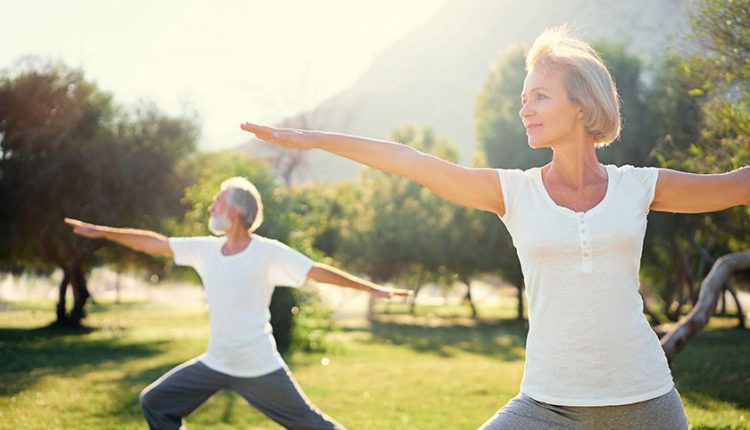
The goal of balance training is to strengthen the muscles that help you remain upright, such as your legs and core, so you can enhance stability and prevent falls. In addition to walking, getting out of a chair, and tying your shoes, having a good balance is crucial in all the activities you do every day, including getting dressed. Your strength and ability to stay steady are crucial in all these activities and many more. Exercises that improve balance can be intense, like some challenging yoga exercises for seniors. Others tend to be simpler, for example, standing on one leg for a short time.
Contents
- 1 Why Should Seniors Improve Their Balance?
- 2 Which Conditions Affect Balance?
- 3 When to Visit a Doctor for Lack of Balance and Falling?
- 4 How to Start to Find Balance?
- 5 Benefits of Balance Exercise for Seniors
- 6 Exercise Cautions for Seniors
- 7 Balance Exercises for Seniors
- 8 Balance Exercises with a Walker
- 9 How Often Should Seniors Do Balance Exercises?
- 10 Can You Do Balance Exercises at Home?
- 11 Can You Do Balance Exercises with a Heart Condition?
Why Should Seniors Improve Their Balance?
The ageing population typically experiences joint pain and decreased muscle mass caused by arthritis. Each of these problems can harm mobility. Dizziness, weakness, changes in cognition, and other age-related medical conditions may increase a senior’s fall risk. The good news is that doing some simple, low-impact exercises for seniors to improve balance at home can decrease their risk of falling. Best of all, caregivers and seniors can perform these moves together to ensure their safety and prevent accidents. Seniors can also build muscle by doing the right dumbbell exercises and consuming enough nutrition. Read more abouthow can seniors build muscles.
Which Conditions Affect Balance?
According to CDC,
many conditions contribute to falling. These are known as risk factors. Many risk factors are modifiable to prevent falls. Including:
- Weakness in the lower body
- Vitamin deficiency in seniors, mainly Vitamin D
- Difficulties with walking or balance
- Use of medicines
- Vision problems
- Foot pain
Most falls are the result of a combination of risk factors. The more risk factors present, the greater the person’s chances of falling.
When to Visit a Doctor for Lack of Balance and Falling?

Asking yourself some key questions can help you identify a balance problem. Whenever you answer “yes” to any of these questions, talk to your doctor about the symptom.
- Are you feeling faint or lightheaded?
- Is your balance unsteady?
- For brief periods, does it seem as if the room is spinning around you?
- When you’re standing or sitting still, do you feel as if you are moving?
- Do you experience blurry vision?
- Are you easily thrown off balance?
- Do you feel like you are falling?
- Are you feeling disoriented, losing your sense of time or place sometimes?
How to Start to Find Balance?
You can start your balance exercises by following these tips:
- Identify your dominant leg and begin each exercise on the other leg so that the other side is more leisurely.
- During the position, maintain good form and posture.
- Maintain your balance by gazing straight ahead.
- Consider putting your feet a little farther apart if you have trouble staying balanced while standing.
- By bending your knees slightly, you will avoid hyperextensions, and you will also be more stable.
- Spread your weight evenly between your feet. Keep an eye out for any tendency to lean more on one foot or a move in your weight forward or backward.
- Once your balance improves, you can try closing one eye at a time, gazing up at the ceiling, or changing your arm positions.
- Practicing balance exercises can be challenging for seniors. Make sure you have a stable family member with you when you practice the exercises.
- Pay attention to the nutrition you get before exercise. What to eat before a workout for seniors and what to drink before a workout are essential.
Benefits of Balance Exercise for Seniors
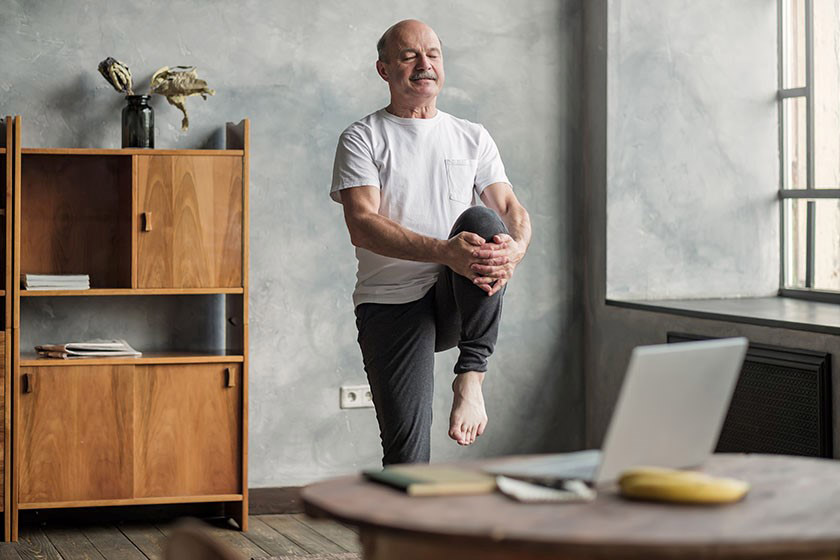
In addition to preserving independence and mobility, balance exercises can:
- Make Everyday Activities Easier: A healthy balance can assist seniors with completing various daily tasks, including making the bed, tying shoes and reaching higher shelves.
- Encourage more exercise: As seniors’ balance improves, they often gain the confidence they need to participate in other types of physical activity, such as walking around the block every day or gardening.
- Prevent Falls and Injuries: Researchers found that seniors who exercised with balance training reduced the risk of falling by nearly 40 percent. Better coordination can reduce the risk of serious injury if they accidentally fall. Falls are prevented by naturally rolling rather than crashing to the floor when a fall takes place.
- Burn Calories: Since most balance exercises require you to exert some effort to remain stable, they can work for several key muscle groups, meaning they burn some calories and help you have a healthy weight and BMI range for seniors; Therefore, they are considered as best exercises for seniors to lose weight.
Seniors can have a better life through exercise. Alongside the physical health benefits of balance exercises for seniors, you can also experience psychological benefits.
Exercise Cautions for Seniors
A balanced routine can be highly beneficial to seniors, but you should still approach it with caution. Make sure you start with more straightforward exercises and gradually progress to more challenging ones. To prevent falls, use a chair or wall for extra support. Before you begin these exercises, drink plenty of water, and eat a healthy snack. During exercise, you should take breaks if necessary. There are some potential dangers of exercise for seniors; for a safer exercise and the best result; Pay attention to the list below:
-
Those who experience vertigo, ear infections, Meniere’s disease, chronic dizziness, or drug interactions should consult their doctor immediately.
-
Do not make quick turns or changes in position.
-
Ask your doctor if any side effects may cause lightheadedness or decreased balance in the case of medications.
-
And if working with a senior with impaired balance or the frail elderly, make sure they’re closely supervised at all times.
Balance Exercises for Seniors
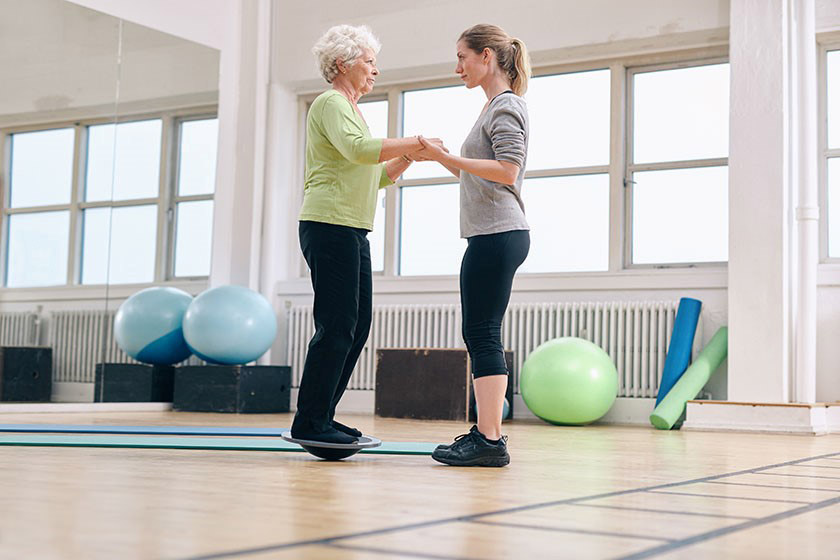
If possible, find a supervisor or support person to supervise you and provide assistance. Use a yoga mat to cushion yourself and keep you from slipping. Over time, you will improve your balance and move on to more complex variations and exercises. Here is a list of ten low-impact exercises for seniors to improve balance. You can do these exercises at any level.
Rock the Boat
The benefits of this exercise include: improve balance, stretch hamstrings, strengthen the spine, and reduce stress.
- Put your feet hip-distance apart.
- Spread out your arms wide to the sides.
- Lift your left foot off the floor and bend your knee so your heel is facing down.
- Keep this position for 30 seconds.
- Next, repeat on the opposite side.
- Do this pose Three times on each side.
Single-Limb Stance
Doing a single-limb stance helps seniors have a better range of motion. This exercise is also a great way to increase balance.
- Grasp the back of a stable, solid chair and hold on to it.
- Balance on your right foot and raise your right foot.
- If you can hold that position for a while, switch sides.
Standing on one foot without holding onto the chair should be your goal, and holding that position for a minute is perfect.
Weight Shifting
Besides improving coordination, weight shift exercises strengthen the muscles in the lower extremities and teach more precise movements in older adults. Seniors should speak with a fitness professional who understands the functional needs, including balance training recommendations. With this simple exercise, you can improve your posture, core strength, and balance.
- Stand with your feet hip-width apart.
- Place your weight on your right foot.
- Raise your left foot.
- For 30 seconds, hold this position.
- Do the opposite side next.
- Perform on both sides three times.
Wall Pushups
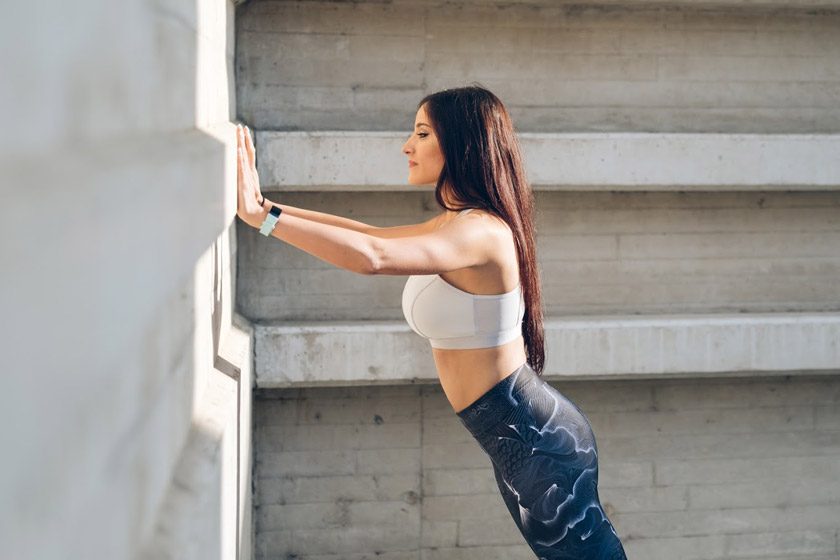
Wall pushups are among the best exercises for seniors to lose weight. This balance exercise for seniors does not require specialized equipment to do this strength training exercise for seniors; all you need is a wall.
- Face a blank wall without any paintings, decorations, windows or doors at arm’s length.
- Place your palms flat on the wall at the height and width of your shoulders and lean forward slightly.
- As you slowly approach the wall, keep your feet planted.
- Straighten your arms by gently pushing yourself back.
- Repeat for 20 times, if possible.
Tightrope Walk
Tightrope walk is one of the best low impact exercises for seniors to improve balance. This exercise is an excellent way to improve core strength, posture, and balance.
- Extend your arms out to the sides.
- Focus on a fixed point in the distance while walking in a straight line.
- Whenever you raise your foot, pause for 2 to 3 seconds.
- Step 20 to 30 times.
Flamingo Stand
With this exercise, you’ll balance on one leg while holding the other back like a flamingo. You’ll also be exercising your core, which also helps with balance.
- Put your weight on your right foot.
- Raise your left leg and extend it forward.
- Keep this position for 10 to 15 seconds.
- Raise the difficulty by reaching your hands toward the extended foot.
- Back into starting position, shake out your legs.
- Repeat three times.
- Next, repeat on the opposite side.
Marching in Place
Marching is a perfect balance exercise for older adults. Try this exercise in front of a counter if you need to hold onto something.
- Stand straight.
- Raise your right knee as high as you can.
- After lowering the right leg, raise the left leg.
- Try raising and lowering your legs twenty times.
Back Leg Raises
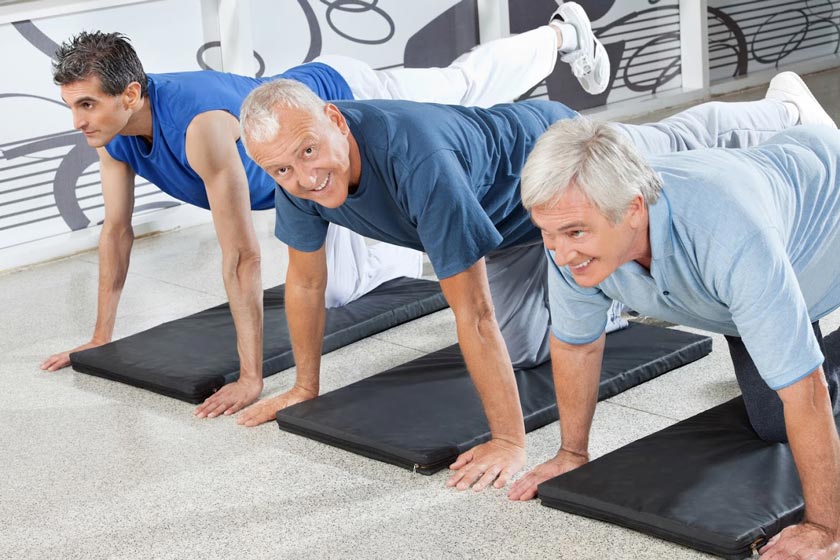
The exercise strengthens your back and glutes, which will help you maintain a good posture.
- Hold your hands against a wall or chair back.
- Put your weight on your right foot.
- As high as you can, slowly lift your left leg back.
- For 5 seconds, hold this position.
- Get back to the starting position.
- Repeat ten times. Then do the opposite side.
Walking Heel-to-Toe
The exercise improves your balance and helps strengthen your legs.
- Stand with your heels pressed against the wall.
- Position your left foot in front of your right foot.
- Touch your left heel to your right toes.
- Put your right foot in front of your right foot.
- Touch your right heel to your left toes.
- Then repeat 20 steps.
Balance Exercises with a Walker
A walker can return independence to people who have been injured or had surgery or have balance and gait issues, fatigue, or muscle weakness. Here are four of the best balance exercises for seniors with a walker.
Marching with a Walker
Marching improves balance and core stability while strengthening hip flexors and glutes. It prevents fall-related injuries.
- Stand and put both your hands on your walker.
- As high as you can, raise your left knee.
- Lower it and then lift your right knee.
- Continue alternately between the sides for a total of 20 repetitions.
Lifting Leg
This low-impact exercise for seniors to improve balance gives you a better range of motion in the hips, along with better body stabilization.
- Using a slow, controlled motion, lift your leg to the side.
- To get the best result, do this exercise slowly.
- Lift each leg ten times.
Heel-Toe Raises
In toe raises, you primarily engage muscles in the lower leg, including the tibialis anterior, which controls foot flexion and toe elongation.
- Stand with both hands on your walker.
- Raise both heels and stay balanced on the balls of your feet for three seconds.
- Now shift the weight onto your heels and raise your toes.
- Repeat 10-20 times.
Squats with a Walker
Squats are among the best balance exercises for seniors. Doing squats helps strengthen the muscles of your lower body.
- Stand with your feet about shoulder-width apart.
- Slowly bend your knees, being sure not to go too low, especially at first.
- Stand up again and repeat ten times.
How Often Should Seniors Do Balance Exercises?
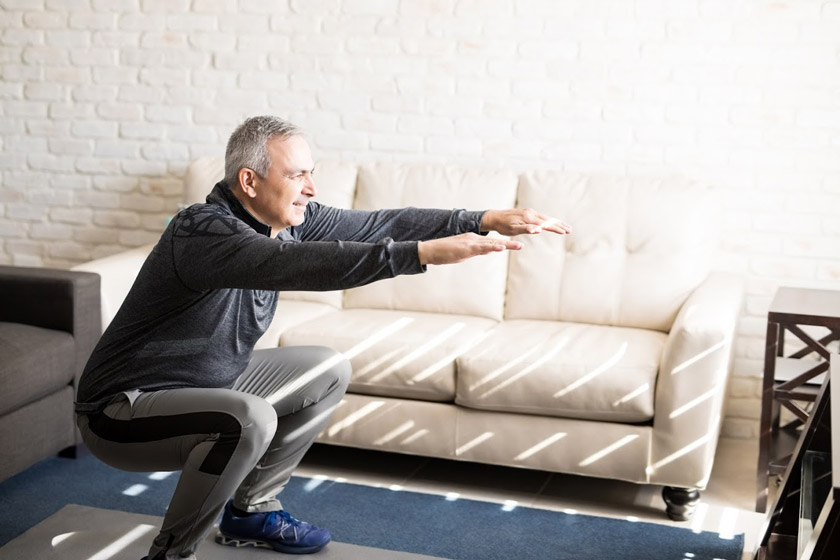
Ideally, older adults should do two to three exercise sessions a week. Performing balance exercises can improve posture, stability, and coordination, build strength, and improve posture. As a result, you are less likely to fall or bump into things, which could cause an injury. You may not recover from injury as quickly as you hope when you fall, so preventive measures are the best way to go. For preventing falls among older adults, it is vital for them to feel comfortable and secure in their movement patterns.
Can You Do Balance Exercises at Home?
Yes. With just a chair, you can do balance exercises on your own. You will have to pay for tai chi or yoga classes, stability balls, videos, or other equipment. Yoga for seniors is an excellent way to stretch and strengthen muscles crucial for balance. But before starting any exercise, know what the best workout time for seniors is.
Can You Do Balance Exercises with a Heart Condition?
After a heart attack, some people are hesitant to exercise. Physical activity, however, can provide you with some protection against further heart attacks. The AHA stated in 2014 that doctors should recommend exercise to stroke patients since physical activity and exercise can improve cardiovascular fitness, walking ability, and upper arm strength after stroke. Be sure to talk to your doctor before engaging in any exercise if you have had a heart attack or stroke so that your exercise program is safe and effective.
Final Words
No matter how old you are, you can start an exercise program or enhance your current one at any time. Besides these exercises, you can improve your balance with walking and chair yoga and yoga for seniors’ exercises. It would be best to eat various healthy foods that allow you to maintain a healthy weight. Seniors with good balance are more likely to feel confident and independent, which can improve their overall quality of life. By investing time in improving balance, seniors can enjoy greater mobility and reduced risk of falls, ultimately leading to a more fulfilling and active lifestyle.
My wife is 57, and she doesn’t have any health conditions. she practices Pilates five times a week since 18 years ago. I’ve never seen her having balance issues, but sometimes she does feel light-headed. Her last checkup result was normal, and she didn’t have any vitamin deficiency. Could it be because of working out a lot?
“Sometimes” is nothing to be concerned about, in my opinion. We all feel dizzy and find it hard to balance ourselves once in a while. And since your wife works out a lot, I’m going to go ahead and assume that’s natural. But if at any point it gets frequent, you should consult a doctor right away.
Is she on a specific diet? Some low carb or low-calorie diets can have this effect. If that’s the case, a doctor or a nutritionist can help you. Being hydrated is also essential. Does she drink enough water?
I don’t think it’s something you need to worry about but tell her not to exhaust herself with working out and eat well. There are a lot of reasons for feeling light-headed and dizzy. It may be dehydration, low blood pressure, or low blood sugar. But it is normally nothing unnatural and dangerous if it is not that frequent. But I also agree with Eric, who responded to your comment earlier. You should definitely tell her doctor about this if it goes on like this for too long or starts to happen more often.
Hi everyone! I’m so worried about my grandpa. It’s been a week since he can not stand on his feet properly. He constantly falls, and he needs a wall or walker to walk! The doctors said it’s because of the pills he consumes, but it seems like it’s not about the pills. Is it natural? Am I too worried?
Of course you’re NOT too worried! It’s a big problem which you should take it more seriously. If the doctor says It’s about the pills, change them or even cut them off. Imagine he lose his balance somewhere dangerous like street or bathroom; disaster!
Hi Aurora. You have every right to be worried. I suggest you talk to his doctor to see if they can change his pills. If the pills are not vital to his health or can be substituted with something else, then ask them to do so. You can also change his doctor and see what other experts think about his situation. You might find a whole new cause or solution to his situation. There are several exercises that seniors can do from the bed. These workouts are remarkable for their bodies and can help them keep their balance easier. Ask his doctor about such exercises and tell your grandpa to do them regularly. I hope he feels better soon.
Well, my recommendation is to mix balancing exercises into your daily life. I walk on the rail of railroad tracks. And on the curb of sidewalks. You have to use it or lose it.
And if you lose it, you can get it back. Six months ago, I couldn’t take two steps on the rail. Now I do 150 without falling.
If I can, you can.
Walk in the forest, stand on one leg while brushing your teeth and then close your eyes and rise to your toes.
Make sure you don’t hit your head on the sink, though!
My grandma is 91 and walks slowly with a walker. Her feet get bruised and painful when standing for more than a quarter. She also has heart issues. Can she benefit from these balance exercises? Does anybody with similar conditions have any experience?
Because of my weak ankles, I cannot do balance exercises; my body aches and shivers whenever I do them. Anyway, thanks for sharing this informative article. It will be good to consider writing about special exercises for someone like me.
Have you ever visited a physiotherapist or doctor regarding your special condition? They might recommend special exercises to you.
Staying physically active by exercising and following a mild workout routine is probably the best thing a senior can do for themselves. I strongly agree with the final words of this article. Start taking small steps and don’t worry about leaping with big ones before taking these small steps regularly and steadily.